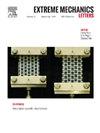Model elasto-plastic metamaterials as generic computing platforms
IF 4.5
3区 工程技术
Q2 MATERIALS SCIENCE, MULTIDISCIPLINARY
引用次数: 0
Abstract
Mechanical metamaterials are engineered materials constructed from elementary building blocks, typically arranged in regular patterns. These materials are generally studied for their effective properties, which are determined by the arrangement of their building blocks rather than the material they are made of. However, new functionalities are emerging, with mechanical metamaterials now exhibiting capabilities similar to conventional computers. For instance, they have been used to store binary data and even perform simple computations such as small binary additions and multiplications. These computing devices could be valuable in extreme environments where traditional electronic systems fail to operate. Moreover, they can process data autonomously without requiring a sustained power source. Despite this potential, there are no established design principles for systematically developing such computational materials. In this work, we explore the use of a model elasto-plastic metamaterial – a two-dimensional lattice composed of linear and bistable spring–mass systems – for executing sequential algorithms. While previous studies on mechanical computing mostly focused on small devices, we show that the lattice can be crafted to execute algorithms with many steps and large inputs, such as -bit binary number additions. To our knowledge, this model has never been used for computational purposes before. This work thus offers a novel perspective on such models, proposing them as generic computing platforms that can be harnessed to design new computational materials.
模拟弹塑性超材料作为通用计算平台
机械超材料是由基本构件组成的工程材料,通常以规则的模式排列。人们通常研究这些材料的有效性能,这些性能是由它们的组成部分的排列决定的,而不是由它们的材料决定的。然而,新的功能正在出现,机械超材料现在表现出与传统计算机相似的能力。例如,它们被用来存储二进制数据,甚至执行简单的计算,如小的二进制加法和乘法。这些计算设备在传统电子系统无法运行的极端环境中可能很有价值。此外,它们可以在不需要持续电源的情况下自主处理数据。尽管有这种潜力,但目前还没有确定的设计原则来系统地开发这种计算材料。在这项工作中,我们探索了使用模型弹塑性超材料-由线性和双稳态弹簧质量系统组成的二维晶格-来执行顺序算法。虽然先前对机械计算的研究主要集中在小型设备上,但我们表明,晶格可以精心设计,以执行具有许多步骤和大输入的算法,例如n位二进制数加法。据我们所知,这个模型以前从未被用于计算目的。因此,这项工作为这些模型提供了一个新颖的视角,提出它们可以作为通用的计算平台,用于设计新的计算材料。
本文章由计算机程序翻译,如有差异,请以英文原文为准。
求助全文
约1分钟内获得全文
求助全文
来源期刊

Extreme Mechanics Letters
Engineering-Mechanics of Materials
CiteScore
9.20
自引率
4.30%
发文量
179
审稿时长
45 days
期刊介绍:
Extreme Mechanics Letters (EML) enables rapid communication of research that highlights the role of mechanics in multi-disciplinary areas across materials science, physics, chemistry, biology, medicine and engineering. Emphasis is on the impact, depth and originality of new concepts, methods and observations at the forefront of applied sciences.
 求助内容:
求助内容: 应助结果提醒方式:
应助结果提醒方式:


